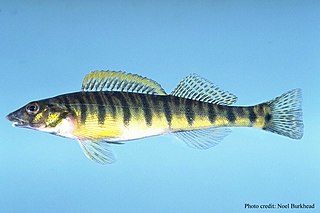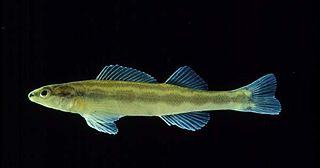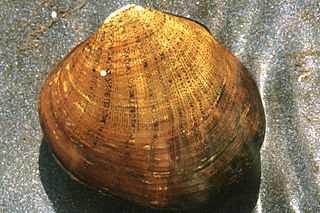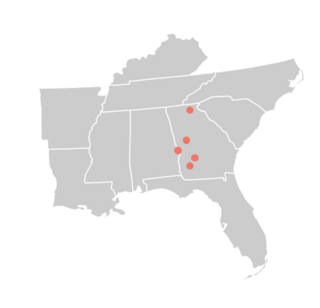
Percina is a genus of small freshwater ray-finned fish, classified within the subfamily Etheostomatinae, part of the family Percidae, which also contains the perches, ruffes and pikeperches from North America. Like the similar fishes in the genus Etheostoma, they are some species called "darters". More specifically, the genus as a whole is known as roughbelly darters, while certain species of Percina with a pattern of vertical bars on the flanks are called logperches.

The leopard darter is a species of freshwater ray-finned fish, a darter from the subfamily Etheostomatinae, part of the family Percidae, which also contains the perches, ruffes and pikeperches. It is native to the United States, where it can be found only in the Little River drainage in Oklahoma and Arkansas. Its typical habitat is medium to large streams with rubble and boulder substrate. It feeds on small invertebrates on the riverbed and spawns mainly in March and April. It is threatened by impoundment, habitat loss and runoff from agricultural activities. It has never been a common species and has been listed as a threatened species in the United States since 1978, and the International Union for Conservation of Nature lists it as a "vulnerable species".

The goldline darter is a small species of freshwater ray-finned fish, a darter from the subfamily Etheostomatinae, part of the family Percidae, which also contains the perches, ruffes and pikeperches. It is found in the United States, primarily in the Cahaba River in central Alabama and the Coosa River in Georgia and Alabama. It is a small fish seldom exceeding 3 in (7.6 cm) in length. It is typically found in areas with moderate to swift currents and a water depth of over 2 ft (60 cm), in the main channels of free-flowing rivers with a rock, cobble or boulder base and aquatic plants. It has been federally listed as a threatened species since April 22, 1992, and the International Union for Conservation of Nature has classified its conservation status as being "vulnerable".
Percina austroperca, the southern logperch, is a small species of freshwater ray-finned fish, a darter from the subfamily Etheostomatinae, part of the family Percidae, which also contains the perches, ruffes and pikeperches. They are highly resilient with a minimum population doubling time of less than 15 months. It is found in the Escambia and Choctawhatchee river systems in western Florida and southern Alabama.
The freckled darter is a species of freshwater ray-finned fish, a darter from the subfamily Etheostomatinae, part of the family Percidae, which also contains the perches, ruffes and pikeperches. It is endemic to the United States.
The longnose darter is a species of freshwater ray-finned fish, a darter from the subfamily Etheostomatinae, part of the family Percidae, which also contains the perches, ruffes and pikeperches. It is endemic to the United States.

Dromus dromas, the dromedary pearlymussel or dromedary naiad, is a rare species of freshwater mussel in the family Unionidae. This aquatic bivalve mollusk is native to the Cumberland and Tennessee River systems in the United States, where it has experienced a large population decline. It is a federally listed endangered species of the United States.

Medionidus penicillatus, the gulf moccasinshell, is a rare species of freshwater mussel in the family Unionidae, the river mussels. This aquatic bivalve mollusk is native to Alabama, Florida, and Georgia in the United States, where it is in decline and has been extirpated from most of the rivers it once inhabited. It is a federally listed endangered species of the United States.
Percina kusha, the bridled darter, is a species of freshwater ray-finned fish, a darter from the subfamily Etheostomatinae, part of the family Percidae, which also contains the perches, ruffes and pikeperches. It is one of the 324 fish species found in Tennessee.

The Mobile logperch is a species of freshwater ray-finned fish, a darter from the subfamily Etheostomatinae, part of the family Percidae, which also contains the perches, ruffes and pikeperches. It is found in the Mobile River basin in Mississippi, Alabama, Tennessee, and Georgia in the southeastern United States. It inhabits clear shallow water and is often associated with Podostemum (riverweed). It grows to about 18 cm (7 in) and is distinguishable from other darters by the distinctive shape of its head and by its pale-yellow base color, with narrow bars on back and sides. It feeds on small invertebrates and breeds between February and May. Lake fish move into small streams to spawn. It is a common fish with a wide range and the International Union for Conservation of Nature has classified its conservation status as being of "least concern".

Percina maculata, the blackside darter, is a species of freshwater ray-finned fish, a darter from the subfamily Etheostomatinae, part of the family Percidae, which also contains the perches, ruffes and pikeperches. It is a widespread inhabitant of streams and rivers in the Mississippi River watershed. Like other darters it prefers rocky riffles and sandy runs, but is tolerant of pools and still water as well. It is one of the 324 fish species found in Tennessee.

The blackbanded darter is a species of freshwater ray-finned fish, a darter from the subfamily Etheostomatinae, part of the family Percidae, which also contains the perches, ruffes and pikeperches. It is native to the river systems of the southeastern United States where it is found in the states of South Carolina, Tennessee, Georgia, Florida, Mississippi, Alabama, and Louisiana. It lives over sandy or gravelly bottoms in smaller rivers and streams and its color varies depending on the different habitats in which it lives. It feeds on small insect larvae and is itself preyed on by larger fish. It spawns between February and June depending on locality. It is a common fish throughout most of its range but is rare in the Altamaha River in Georgia.
The bronze darter is a species of freshwater ray-finned fish, a darter from the subfamily Etheostomatinae, part of the family Percidae, which also contains the perches, ruffes and pikeperches. It is restricted to the Coosa and Tallapoosa River systems in Georgia, Alabama, and southeastern Tennessee in the United States. It feeds on insect larvae and other small invertebrates, and spawns in April and May. It is a common fish within its range and the International Union for Conservation of Nature has classified its conservation status as being of "least concern". However, it is susceptible to environmental disturbance and an ongoing management plan has been put in place to protect its habitat.
Percina shumardi is a benthic species of freshwater ray-finned fish, a darter from the subfamily Etheostomatinae, part of the family Percidae, which also contains the perches, ruffes and pikeperches. It is native to North America. It is an inhabitant of small and medium rivers where it occurs in rocky riffles with clear, fast-flowing water. The river darter can reach up to 7.3 cm in length and has an average lifespan of three years. It can be distinguished from other darters by its unique front and rear spots on the dorsal fin.
The saddleback darter is a species of freshwater ray-finned fish, a darter from the subfamily Etheostomatinae, part of the family Percidae, which also contains the perches, ruffes and pikeperches. It is native to the eastern United States. This darter species is widespread, occurring from the Escambia River drainage west to the Mississippi River basin and as far north as the Wabash River historically. Some populations have been reported in the Tennessee River drainage. The saddleback darter is aptly named as it has 5 saddle-like patterns on its dorsum, with the first occurring near the first dorsal fin and the fifth near the caudal penduncle. Adults can attain a maximum size of about 3 inches or 7.8 centimeters. The saddleback darter typically occurs over sand and gravel runs of creeks and small to medium-sized rivers and is sometimes found in very shallow water. This darter's diet consists of invertebrates such as caddisfly larvae, beetles, mayflies, and stoneflies. The saddleback darter deposits eggs over sand and gravel shoals during the spring. This species has an average lifespan between 2 and 3 years.

The Guadalupe darter is a small species of freshwater ray-finned fish, a darter from the subfamily Etheostomatinae, part of the family Percidae, which also contains the perches, ruffes and pikeperches. It is found in the Guadalupe River system in Texas. It prefers fast rocky runs of small to medium-sized rivers. The darter is typically 11.0 cm (4.3 in) in length.
The coal darter is a small species of freshwater ray-finned fish, a darter from the subfamily Etheostomatinae, part of the family Percidae, which also contains the perches, ruffes and pikeperches. It is found in eastern Mobile Bay basin, Alabama. The species' stronghold is in the main channel of the Cahaba River, primarily above the Fall Line. It prefers gravel runs and riffles of small to medium-sized rivers.

The Halloween darter is a small freshwater fish native to North America. It is found in Georgia and Alabama in the drainage basin of the Apalachicola River, specifically in the Flint River system and the Chattahoochee River system. It prefers shallow, fast-flowing areas with gravel bottoms in small and medium-sized rivers. It was first described in 2008, having not previously been distinguished from the blackbanded darter (P. nigrofasciata), which occurs in the same watershed. The color is somewhat variable, being generally blackish dorsally, with some individuals having indistinct saddle-like barring. Males have orange and dark lateral striping while females have dark stripes and a yellowish-green belly. At a maximum standard length of 101 mm (4 in), males are slightly larger than females, and both sexes develop distinctive orange barring on the edge of the first dorsal fin during the breeding season.
The Bankhead darter is a benthic species of freshwater ray-finned fish, a darter from the subfamily Etheostomatinae, part of the family Percidae, which also contains the perches, ruffes and pikeperches. It is found in North America where it occurs in the Sipsey Fork of the Black Warrior River in the Bankhead National Forest in northwestern Alabama. It prefers gravel runs and riffles of small to medium-sized rivers.
The Gulf logperch is a small species of freshwater ray-finned fish, a darter from the subfamily Etheostomatinae, part of the family Percidae, which also contains the perches, ruffes and pikeperches. It is found in North America where it occurs in the coastal river systems Of the Gulf of Mexico from Lake Pontchartrain drainages east through the Pearl and Pascagoula drainages to the Mobile basin. It prefers gravel runs and riffles of small to medium-sized rivers. This species was first formally described in 1992 by Bruce A. Thompson (1946-2007) with the type locality given as the Pearl River at river mile 46.8, below pools at Bluff Sill, about 6 kilometers south of Bogalusa, Louisiana, near Louisiana Highway 21 in Pearl River County, Mississippi.









